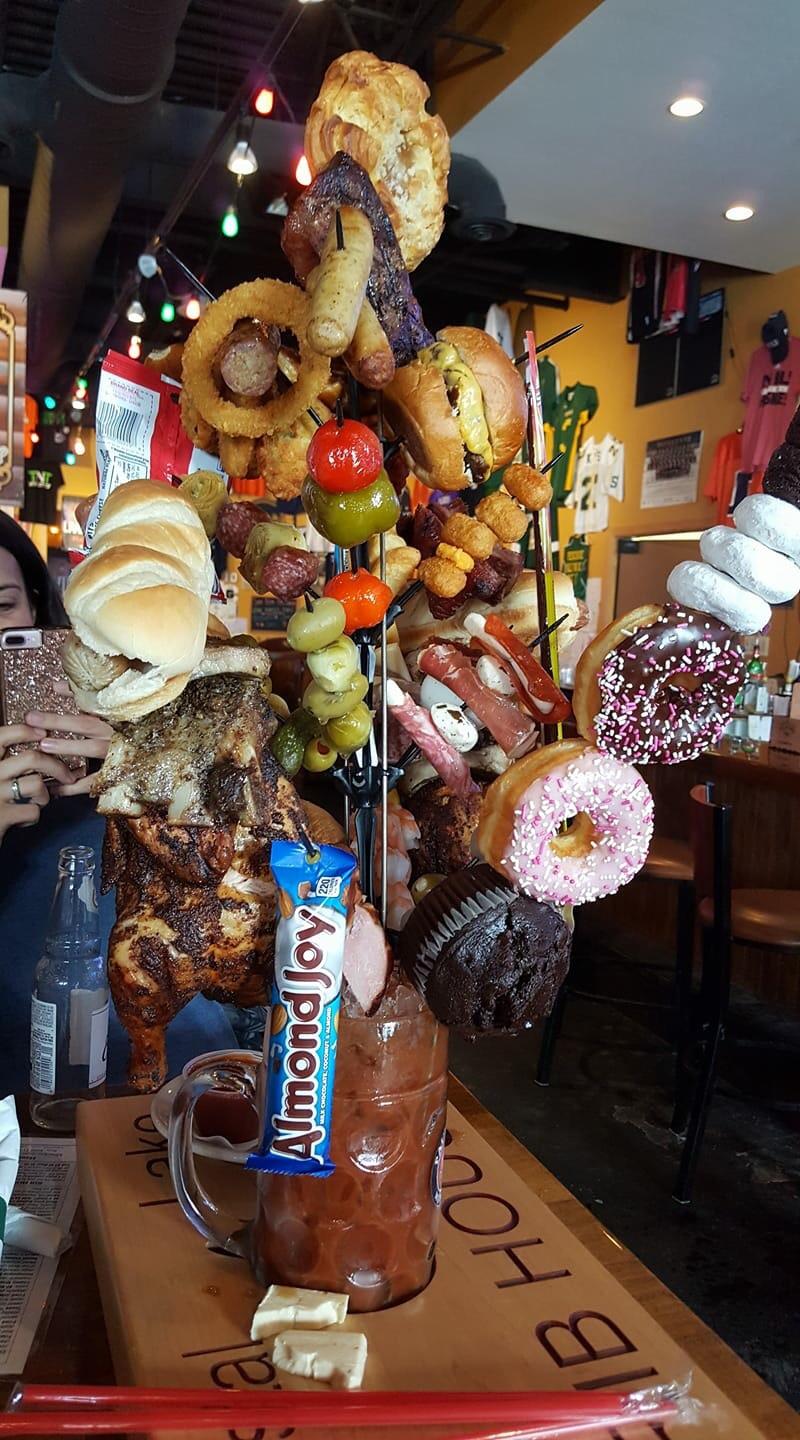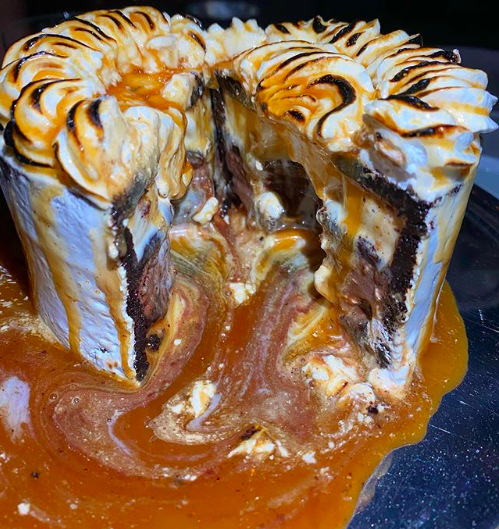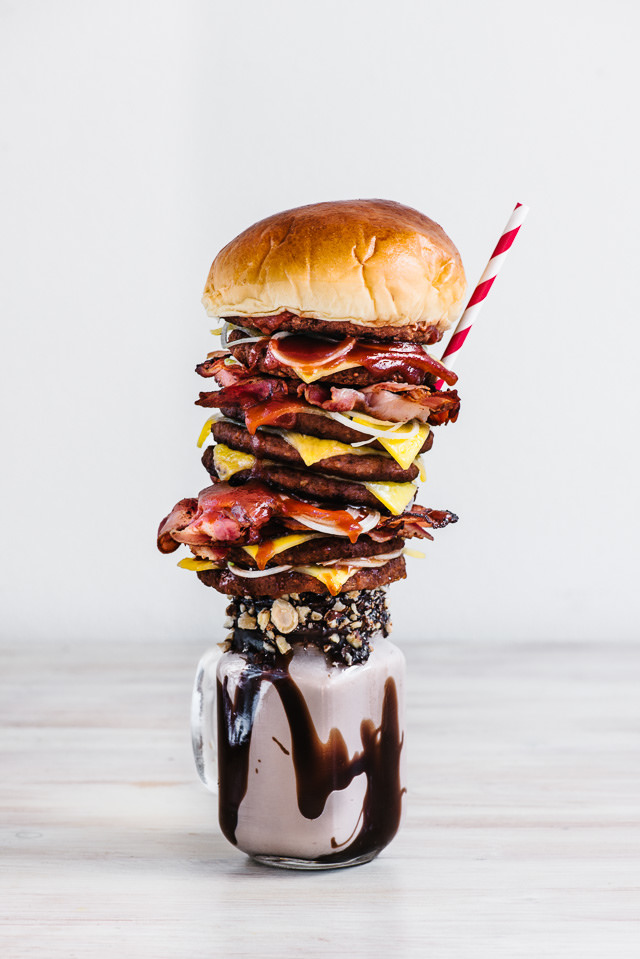The Umami Theory of Value: Autopsy of the Experience Economy
By Nemesis
Where it Started
The year was 2018. Emily, one half of the consulting duo Nemesis, was in NYC for a meeting with one of our clients, a media conglomerate famous for youth engagement who’d commissioned our firm to write a report on why young people weren’t having sex anymore. Once they understood this, they could tailor content to it…or so they thought. (What happens when sex no longer sells?). She was also in town to sit on a panel at the pre-launch of a contemporary art center adjacent to the biggest real estate development in New York’s history, not that anyone can remember what the talk was about. The night before her meeting, her brother took her to a new restaurant on the Upper West Side, which had been an expensive French bistro for decades before rising rents pushed it out.
Emily was entranced by the décor of the new restaurant – a honeycomb of yellow ambient light, a strong glow through amber liquor bottles stacked two stories high, and wood communal tables polished to formality, somehow retro in style while feeling like a live digital render. More hilarious was the menu, which contained only $30 French dip sandwiches (with or without cheese), savage tiny cocktails with savory mixers, and instagrammable 15-layer cakes. Peering down from the mezzanine, she saw groups of young people who looked like they could be in any global luxury environment drinking these cocktails in the amber light and snapping photos of precarious, impossible slices of cake, and it hit her. The restaurant felt contemporary because it was boiled down to only its most savory elements and most photographable ones, and the intersection of these clarified something; all of a sudden it did not seem like a coincidence. Right then she texted Martti: People no longer want sex. They want umami.

Some Background
We are two hybrid strategists and cultural producers who met in Berlin in 2012 and became fast friends. Five years later, we founded Nemesis, which the New Yorker has called an “‘alternative’ consultancy” (emphasis on the scare quotes). We’ve worked with Louis Vuitton, MTV, Art Basel, the Serpentine, Rimowa, and several other clients in luxury, deep tech, and culture. All the while we’ve been conducting our own cultural research, some of which was presented at the Guggenheim Bilbao “Architecture Effects” exhibition, and most of which has languished in our iMessages. Outside of Nemesis, Emily is a writer and Martti is half of Amnesia Scanner.
Since we started getting ready to publish this research, a global pandemic struck, markets crashed, and the possibility of a democratic socialist presidency in America started to fade. Much of our work with clients has been about how to address new audiences in a time of massive fragmentation and the collapse of consensus reality. All the while, people have been eager to launch new products more focused on impressions than materiality, and “spending on experiences” has become the standard of premium consumption.
Now that nearly every major public event, festival, club night and in-person meeting has been cancelled or postponed, flights are banned, borders are closing, and global business has screeched to a halt, it’s time to reassess the consumer experience that came along with the neoliberal fantasy of “unlimited” movement of people, goods and ideas around the globe. That fantasy obviously contributed to a particular reality: refugee and migrant crises, shortages of essential items, and the rise of far-right movements, fake news, and mass ignorance.
Thesis
We believe that umami has been both literally and figuratively the key commodity of the experience economy. Umami, as both a quality and effect of an experience, popped up primarily in settings that were on the verge of disintegration, and hinged on physical pilgrimages to evanescent meccas.
We also believe that the experience economy is dying, its key commodity (umami) has changed status, and nobody knows what’s coming next.
What do we mean by umami? Not only the meatiness of the French dip sandwich at that restaurant, but also the light as it refracted through the amber liquid of the cocktails, the reflection off the back bar, the quivering of the cake, and, most significantly, the way those elements read in a photo. Umami was the quality of the media mix or the moodboard that granted it cohesion-despite-heterogeneity. Umami was also the proximity of people on Emily’s museum panel, all women who are mostly not old, mostly not straight, and mostly doing something interesting in the arts, but we didn’t know exactly what. It was the conversation-dance experience and the poet’s play and the alt-electronica-diva’s first foray into another discipline. It was the X-factor that made a certain MA-1 worth 100x as much as its identical twin. It was miso experiments at the Schindler house; the sting of a targeted facial acid; the endless, senseless brand collabs, like the fungi that can mate with their own DNA. It was Levi’s 501s as a category of experience, not a cut of jean. It was Impossible Burger, obviously. It was quite literally the centerpiece of a large portion of Netflix’s programming (comparable only to drugs and the stories of traumatized athletes).

Umami could have been anywhere, but we smacked our lips in the moment. It was liquid in the sense that it flowed from place to place, airy in the sense that it was ungrounded, and earthy in the sense that it might have been in your mouth.
“Advanced consumers” became obsessed with umami and then ran around trying to collect ever-more-intensifying experiences of it. Things were getting more and more delicious, more and more expensive, and all the while, more and more immaterial.
Umami is what you got when you didn’t get anything.
End of a Cycle
The recent historically long market expansion began with the recovery from the 2008 global financial crisis – and its inevitable end seems to have arrived via virus. Your impression of these high times might vary. You might remember the period for austerity, the Arab Spring, Trump, Brexit, Yellow Vests, the rise of the far right, rising costs of housing and health care, the student debt bubble, youth unemployment, and to top it all off, an accelerating climate crisis. But if you worked in finance, received tech compensation or VC money, or just happened to be rich in the first place, you’ve had a pretty sweet decade.
But now, amidst market turmoil and a public health crisis which much of the world – in particular the US – is fully unequipped to handle, it’s a flaming question mark whether any real growth occurred during this period, or if the high times were merely a fantasy created mainly by capital injections (or “money printing”) from central banks in the US, China, and Europe. What was actually happening was the enrichment of financial assets over the creation of any ‘real wealth’ along with corresponding illusions of progress.
As very little of this newly minted money has been invested into building new productive capacity, infrastructure, or actually new things, money has just been sloshing around in a frothy cesspool – from WeWork to Juicero to ill-advised real estate Ponzi to DTC insanity, creating a global everything-bubble.
With interest rates approaching zero, or even going negative, it simply means capital is having difficulties finding profitable places in which to invest itself. Or, to phrase it differently, those in charge of capitalist societies were failing to see worthwhile futures in which to invest. The market expansion of the past 12 years has felt like a very inappropriately timed self-congratulatory party, situated at the end of a much longer period of stagnation and decadence.

Value, in an economic sense, is theoretically created by new things based on new ideas. But when the material basis for these new things is missing or actively deteriorating and profits must be made, what is there to be done? Retreat to the immaterial and work with what already exists: meaning.
Meaning is always readily available to be repeated, remixed, and/or cannibalized in service of creating the sensation of the new.
How has this manifested? For example, by calling things that were actually old → new; mediocre → premium; bad → good; low value → high value etc. This was Premium Mediocrity. Or by taking existing meanings and mixing them into increasingly novel, bizarre and random combinations and calling them new. This was creative direction. Or by putting people into proximity with newly created meaning of dubious status, and selling it as an experience. This was festival season.
The essential mechanics are simple: it’s stating there’s a there-there when there isn’t one. And directing attention to a new “there” before anyone notices they were staring at a void. It’s the logic of gentrification, not only of the city, but also the self, culture and civilization itself.
What’s made us so gullible, and this whole process possible, was an inexhaustible appetite for umami.
What Does this Have to Do with Actual Umami?
Umami was first scientifically identified by Kikunae Ikeda at Tokyo Imperial University in 1908. He called it umami, which means deliciousness or savoriness. Five years later, his disciple Shintaro Kodama found that dried bonito flakes contained another umami substance, ribonucleotide IMP, which some decades later was also detected in shiitake mushrooms, this time by Akira Kuninaka. Kuninaka’s 1957 research revealed the synergistic effect of ribonucleotides and glutamate: when foods containing one are combined with the other, the resulting taste intensity is significantly more than the sum of its parts. This umami synergy explains classic food pairings: dashi + kombo, Chinese leek + cabbage in chicken soup, Italian parmesan + tomato sauce + mushrooms.
Beyond its synergistic effect, umami has a few other sensory effects that are relevant to our theory. For one, it creates the sense of thickness and body in food. (“Umami adds body…If you add it to a soup, it makes the soup seem like it’s thicker – it gives it sensory heft. It turns a soup from salt water into a food.”) For another, it’s released when foods break down into parts. (“When organic matter breaks down, the glutamate molecule breaks apart. This can happen on a stove when you cook meat, over time when you age a parmesan cheese, by fermentation as in soy sauce or under the sun as a tomato ripens. When glutamate becomes L-glutamate, that’s when things get “delicious.””) These three qualities: SYNERGY, IMPRESSION OF THICKNESS, and PARTS > WHOLE, are common to cultural umami, as well.
Malcolm Gladwell’s 2004 New Yorker article on ketchup was an important “tipping point” in the awareness of umami among Western elites. Umami became the invisible exotic element to be captured among “ethnic” foods in urban environments. Hunting for things to eat became the IRL corollary to indie music fandom in the age of online piracy and streaming. Umami hunting was a way for the West to consume an exotic, ethnic, global “taste” that was also invisible and up to their decoding / articulation.

NPR began to theorize deliciousness in 2007. But the New Yorker maintained its beat (roughly 70 articles mention umami to date). In 2013, the magazine profiled David Chang’s experimental taste lab, The Umami Project.
“New York is a multi-ethnic olio of potential umamis, some waiting to emerge and some already molding and fermenting in invisible, agitated unions of spores and enzymes. “We wanted to create something that, when you taste it—well, you know where you are and who we are,” Felder said, filling a new spoon with a miso of cashew nuts, and another with a pine-nut miso, then moving on to a lentil miso (a work in progress). … People talk about ‘terroir.’ Well, we want the taste of the microbial terroir, which isn’t romantic but supplies the flavor.”
Adam Fleishmann, the proprietor of the chain umami burger, linked umami and the takeover of urban space for the New Yorker in a less poetic, more marketable way:
The answer: UMAMI, PERIOD. You don’t stand in line for something merely salty.
David Chang & Paradox as Driver of Consumption
We’ve been fascinated by one canonical umami text for some time now: David Chang’s Unified Theory of Deliciousness: The Secret Code to Unleashing the World’s Most Delicious Flavors, published in Wired in 2016.
Chang’s text begins with the blockbuster pork bun that catalyzed Momofuku’s success, and established his key metric: “I’d ask, ‘Is this dish good enough to come downtown and wait in line for’ If not, it’s not what we’re after.” Essentially, Chang spells out the link between umami and gentrification. It is literal umami that makes us travel 17 subway stops to spend time in an uninsulated leaking warehouse. One to five years later, metaphorical umami makes the combination of the food and the authenticity of the space somehow culminate in a desire to pay prohibitively expensive rent in a postindustrial wasteland.
Chang’s approach to food is cerebral; he claims to be better at thinking about food than cooking it. For him, hitting the right flavor is grounded in Hofstadter’s idea of the strange loop: when something is correctly salted, Chang argues, it tastes both over and undersalted at once. As a strange loop, this saltiness makes you stand back and regard your food; you start thinking about “the system it represents and your response to it”. He argues that this meta-regard keeps you in the moment and connected to the deliciousness of your food. We counter that it intensifies a moment in a flow, temporarily thickening your experience without keeping you anywhere for long.

Another version of the strange loop comes through deconstructing recipes (two of the examples he uses are “umami bombs”), replacing certain ingredients from similar ones from other cultures, and then creating dishes that are reminiscent of several classics at once. Spicy Pork Sausage & Rice Cakes: at once Mapo Tofu and Bolognese. Cacio e pepi, but with fermented miso instead of parmesan. Umami, silkiness, pungency reads one infographic’s caption, umami, slight sweetness reads another.
His conclusion is this: “Different cultures may use different media to express those base patterns—with different ingredients, for instance, depending on what’s available. But they are, at heart, doing the exact same thing. They are fundamentally playing the same music. And if you can recognize that music, you’ll blow people’s minds with a paradox they can taste: the new and the familiar woven together in a strange loop.”
To us, Chang’s essay gets to the heart of the matter. Through the lens of his theory, we’ve come to see it this way: strong flavors, namely umami, mark a surge of intensity in the flow of experience. It also becomes clear that paradox itself is at the heart of contemporary consumption.
For example:
“This shouldn’t be good but it is”
“This doesn’t seem like what it’s supposed to be”
“This is both too much and not enough”
“I shouldn’t be here but i am”
“This could be anywhere but it’s here”
(see also: the concept of Paradessence)
How it Works
The umami generation process accelerated by breaking cultural things into discrete (marketable) parts through which they become even more consumable and easier to mix into novel, delicious combinations, often across different sensory domains. These combinations could be unstable – as in actually plain dumb, dysfunctional, dangerous – because they didn’t need to last long. There was no value system against which one could measure their worth – beyond the immediate sense of yumminess and the transactions they triggered.
Let’s break it down a little more. Parts > Whole is just another way of saying a combination of things has emergent properties. In itself this doesn’t mean much, as almost any combination of things has emergent properties, especially in the domains of taste and culture. Coffee + vinegar is worse than its constitutive parts. A suit + sneakers is a greater kind of corny than either worn separately. Most emergence is trivial. The Umami Theory of Value centers on losing your sense of what’s trivial and what’s valuable.
In contrast to food, with which one can do a visceral yummy / ew test, combinations of meaning, information, and signs tend to produce more nebulous effects. Is a K-Pop band sponsoring a performing arts program at a German arts institution more than the sum of its parts? Is it interesting? Is X + Y + Z as part of the same lineup at Ö more than each act performing independently? How about Cybotron playing at an Louis Vuitton show? What about Azealia x Worldcoin?

Cultural umami is the vague sense that yes, for some reason, it is. ““This shouldn’t be good but it is” “this doesn’t seem like what it’s supposed to be” “I shouldn’t be here but i am” “this could be anywhere but it’s here” If you tried to unpack your intuition, the absence of the there-there would quickly become evident.
Yet in practice this didn’t matter, because few people were able to reach this kind of deep self-interrogation. The cycle was simply too fast. There was never time for these concoctions to congeal into actual new things (e.g. create the general category of K-Pop patrons for Central European arts institutions). We can’t be sure if they ever meant anything beyond seeming yummy at the time.
Let’s take an example. The luxury sector, fashion in particular, has increasingly become a key theater for umami. Throughout the history of human civilization, luxury was premised on being expensive, meaning it resulted from investing an unreasonable amount of work, material or other scarce resources into the making of a thing.
But today’s rich don’t generally wear the 2020 version of royal purple, something like parametrically fitted garments made of nanofibers embellished with synthetic mother of pearl (which might be the results of real growth). Instead, they wear $500 cotton t-shirts with inscrutable references and visual motifs pulled from a smörgås-moodboard that makes little “sense” in any generalizable way. The t-shirt’s price clearly isn’t a function of its material makeup, but rather a result of some form of manipulation of meaning associated with it. But because meaning (or its substrate information) is infinite, it can only become a luxury once it carries the illusion of scarcity.
Meanings that only a few have access to are secrets. In the absence of meaning, the illusion of a secret is created by imposing a subcultural barrier to entry where only through an opaque process of scene work can one ‘get’ it (or, if you’re unlucky: if you gotta ask you’ll never know…). Alternatively, they are wrapped in the veil of an elusive X-factor, to which only a privileged few, i.e. the creative director, have direct access.
The key referent of luxury brands used to be one thing they made really well at great cost. But today they have gentrified themselves by discarding any fixed material basis: the only referent that does any work is the price, and the wealth associated with it.
By combining the traditional symbols of wealth with a pool of meaning that was made to seem scarce but was in fact infinite, brands created the umami equivalent of free energy. Everyone wanted money and everyone wanted umami. And there was more money around than ever before. What could go wrong?

In Conclusion
We wrote this because we wanted to sum up some of our impressions after working with brands and organizations for almost three years as Nemesis (and many more as solo agents). This was not meant to be a nihilistic, Gen-X faceplant (“nothing means anything any more”), since we think that perspective can paper over the nuances of consumer experience, business realities, and cultural crisis. Instead, we wanted to link macroeconomic and macrotrend observations to everyday experience, especially in the context of burgeoning collapse.
This is what we found: everything is cancelled, and it’s the beginning of the end of the experience economy as we’ve come to know it. The emerging post-umami economy is still nebulous (and will be the focus of upcoming Nemesis memos). Visceral desire may again rise over the paradoxical kind. In the meantime, we suggest thinking about what you wanted, why you got it, and who happens to be holding the L-Glutamate as it all comes tumbling down. And take some time to cultivate a taste for the sour, the bitter and the straight up repulsive – the only flavors of today’s reality pill.
– Emily Segal & Martti Kalliala
Tweet